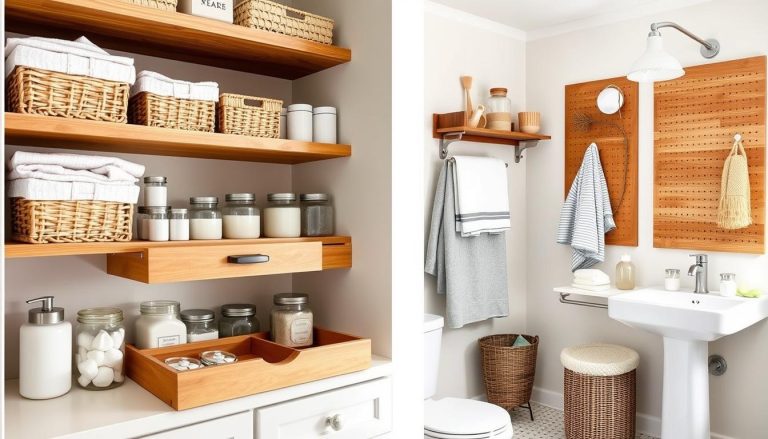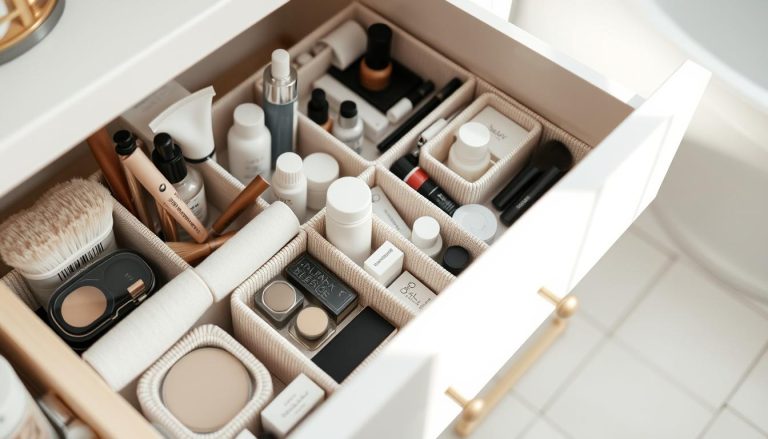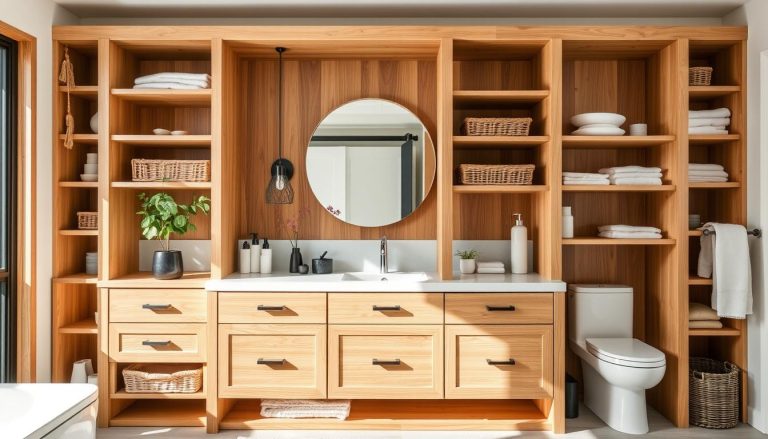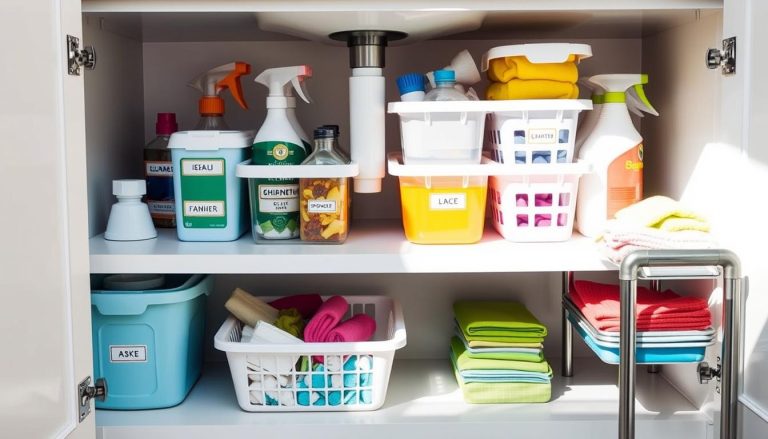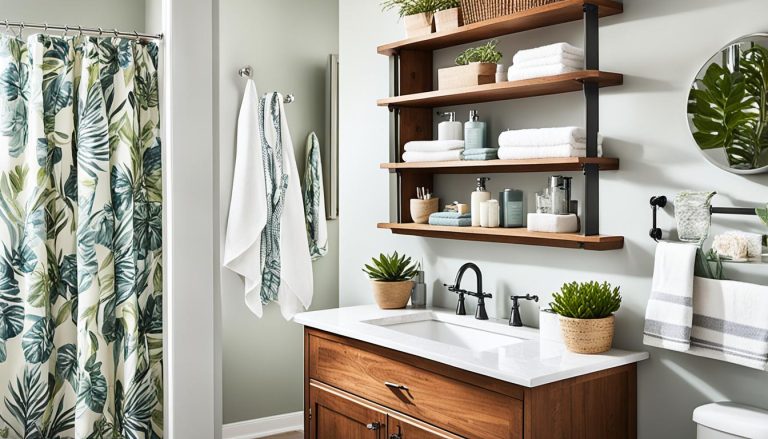Plan Your Bathroom Remodel: Expert Tips & Tricks
houseremodelingnews.com may earn a commission if you purchase a product through one of our links
Did you know up to 72% of costs from a mid-range bathroom remodel can be recouped when selling a home? This fact shows how important a well-planned bathroom makeover is. It can boost your home’s resale value or make your space more functional.
Planning is crucial for a successful bathroom renovation. You need to pick the right fixtures and make the most of storage space. We’ll share expert tips and tricks to help you plan your dream bathroom design. You’ll learn to set realistic goals, stick to your budget, and avoid common mistakes.
Are you ready to turn your old bathroom into a stylish oasis? Let’s explore bathroom remodeling ideas together. With the right approach, your bathroom makeover can be both rewarding and affordable.
Understanding the Scope of Your Bathroom Remodel
A bathroom redesign can be simple or complex. It can range from minor updates to a full makeover. Each type has its own cost and complexity level.
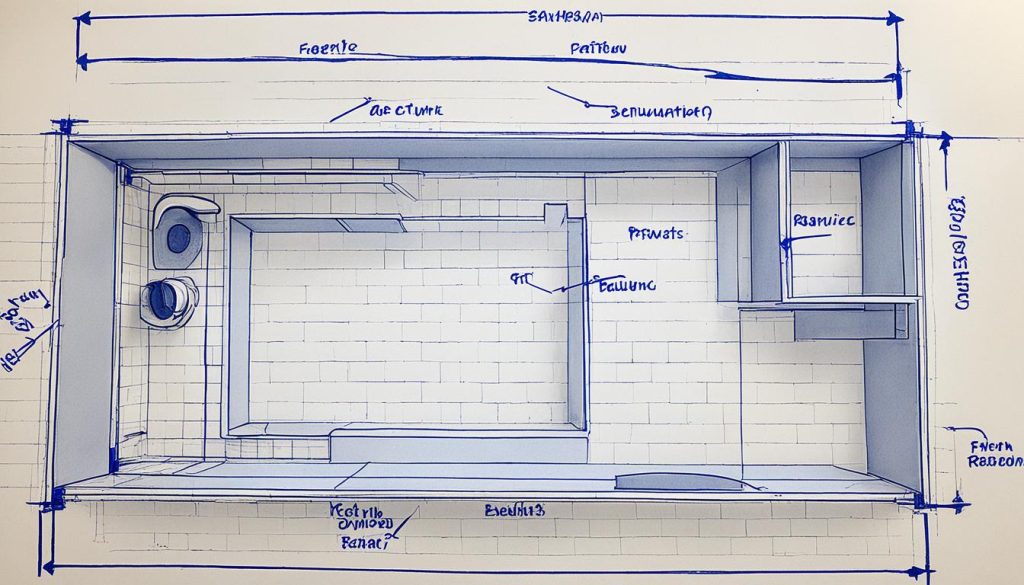
Surface-level alterations
For a budget-friendly update, focus on cosmetic changes. You could swap out fixtures, update the lighting, or paint the walls. These changes refresh your space without costing much.
Gut and replace remodels
Going for a full overhaul means taking everything down to the studs. You’ll replace all the fixtures, flooring, and maybe even walls. This approach offers a complete change but is pricier, costing between $15,000 to $18,000.
Layout changes
Want to make your bathroom more functional? Think about rearranging the layout. Moving the toilet or shower can help. But remember, changing plumbing can raise costs and make things more complicated.
Altering the bathroom footprint
The biggest change involves changing the room’s size or shape. This might mean removing walls or extending the space. Such a project costs $30,000 or more.
“A well-planned bathroom remodel can significantly increase your home’s value and your daily comfort.”
Each bathroom upgrade level needs different skills and planning. Think about your budget, timeline, and what you want to achieve. Whether it’s a simple update or a full makeover, planning is crucial for success.
Setting a Realistic Budget for Your Bathroom Makeover
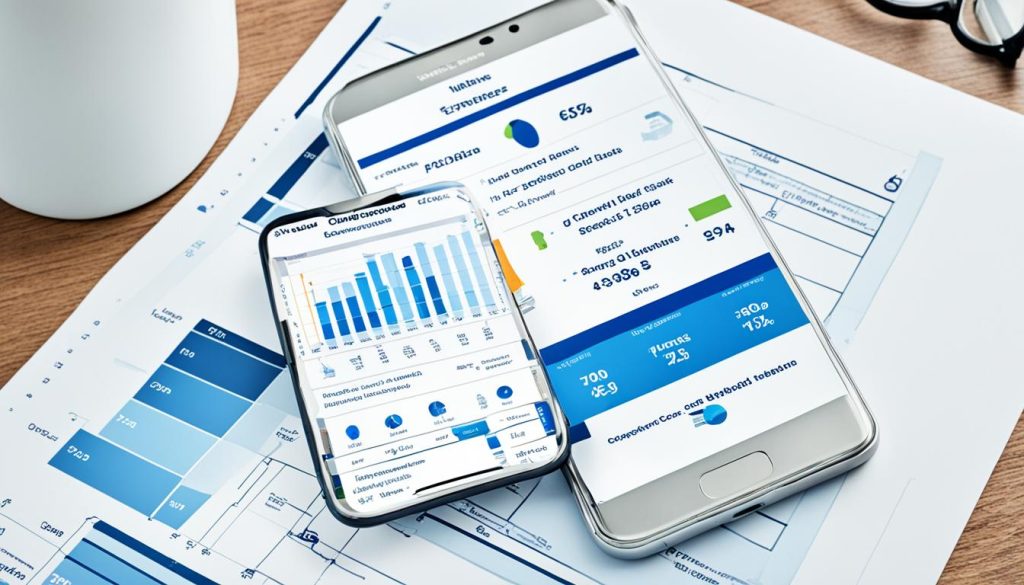
Starting your bathroom remodel means setting a realistic budget. The cost can change a lot based on what you want to do. A simple remodel might cost between $3,500 and $7,000. A full bathroom update usually costs about $19,100.
Think about these important things when planning your budget:
- Labor costs (about 20% of total budget)
- Fixtures and plumbing (14%)
- Cabinetry and hardware (16%)
- Flooring (9%)
- Lighting and ventilation (5%)
Don’t forget to save 20-30% of your budget for surprises. These unexpected costs often pop up during renovations.
Plan your spending wisely. A well-thought-out budget can help you achieve your dream bathroom without breaking the bank.
To cut costs, buy materials on your own. But, always check with your contractor about important items like insulation and drywall.
High-end bathroom remodels can go over $60,000. Your final cost will depend on your choices in fixtures, materials, and layout changes. With a realistic budget and careful planning, you can create a beautiful new bathroom that meets your needs and budget.
Determining Your Bathroom Remodel Goals
Setting clear goals for your bathroom renovation is key. These goals will guide the project, from the layout to the fixtures and storage.

Increasing Space and Functionality
Many homeowners want to make their bathrooms bigger. This might mean adding floating shelves or wall-mounted cabinets for more storage. You could also change the layout to make the space work better.
Modernizing Fixtures and Aesthetics
Upgrading old bathroom fixtures is a common goal. This could mean swapping out bathtubs, sinks, or toilets for new ones. Some people choose to add luxury items like jacuzzi tubs or advanced showers for a spa feel.
Improving Accessibility
It’s important to make bathrooms more accessible, especially for seniors or those with mobility issues. Think about installing walk-in tubs or grab bars to prevent falls. These changes can make the bathroom safer and more comfortable.
Remember, your remodel goals should fit your budget. Materials usually make up 40% of costs, and labor is about 20%. Save an extra 20% for unexpected costs.
“Your bathroom should be a reflection of your lifestyle and needs. Plan carefully to create a space that serves you well for years to come.”
By setting clear goals, you’ll be ready to make smart choices about your bathroom’s design, fixtures, and storage during the remodel.
Choosing Between DIY and Professional Services
When planning your bathroom makeover, you’ll have to decide between DIY or hiring a contractor. Each choice has its pros and cons, depending on your situation.
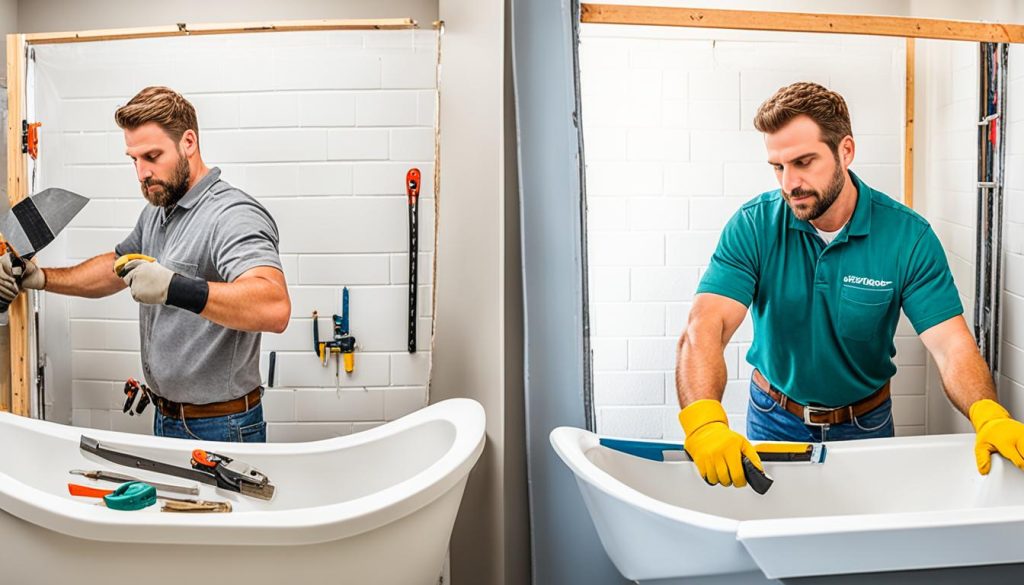
DIY projects can save money and let you add your personal touch. You set the budget and schedule, working at your own speed. It’s a chance to learn new skills and make your space unique. But, DIY projects can take a long time, often up to a year, compared to the 23 days for professionals.
Contractor services offer expertise and speed. They use top-quality materials and tools for the best results. They also handle permits and work quickly. For example, KOHLER LuxStone can install showers in just one day, with a Lifetime Limited Warranty.
Remember, some tasks are best left to experts. Plumbing work, for example, needs professional advice to avoid big mistakes.
Think about your skills, budget, and time when making your choice. Simple tasks like painting or changing accessories are good for DIY. But, complex jobs like tiling or electrical work need a pro. Consider the long-term benefits against the upfront costs. Quality work now can save you money and stress later.
How to Plan a Bathroom Remodel: Step-by-Step Guide
Planning a bathroom remodel is both exciting and challenging. This guide will help you through the key steps for success. By following these tips, you’ll make a space that’s useful and looks great.
Assessing Your Current Bathroom
First, look at your bathroom’s current state. Measure it, note where plumbing and electrical are, and see what needs fixing. This helps you understand what your project will cover and what goals you have.
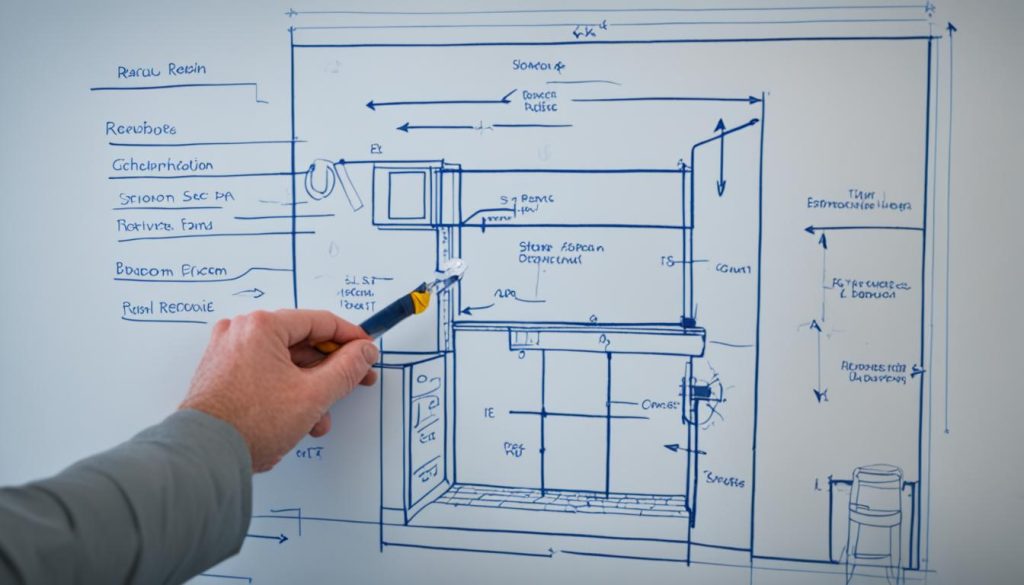
Creating a Design Plan
Make a design plan that fits your vision and budget. Think about changing the layout, adding storage, and what you like in style. A good plan can save you time and money later.
Selecting Materials and Fixtures
Pick materials and fixtures that match your style and can handle the bathroom. Think about how long they last, how much upkeep they need, and their cost. Make sure to include these important items in your plan:
- Flooring options (tile, vinyl, or natural stone)
- Shower or bathtub
- Vanity and storage solutions
- Lighting fixtures
- Plumbing fixtures (toilet, sink, faucets)
Establishing a Timeline
Make a realistic timeline for your bathroom makeover. Think about these main steps:
- Demolition (15% of project time)
- Plumbing rough-in (25%)
- Electrical work (10%)
- Tiling (20%)
- Installing fixtures (22%)
- Painting and finishing touches (8%)
Remember, things might not go as planned, so be flexible with your schedule. With good planning and doing things right, your bathroom remodel will turn your space into a place you love.
Navigating Permits and Building Codes
Are you planning to remodel your bathroom? Remember, permits and building codes are key. They affect your timeline and the contractors you hire. Let’s explore what you should know.
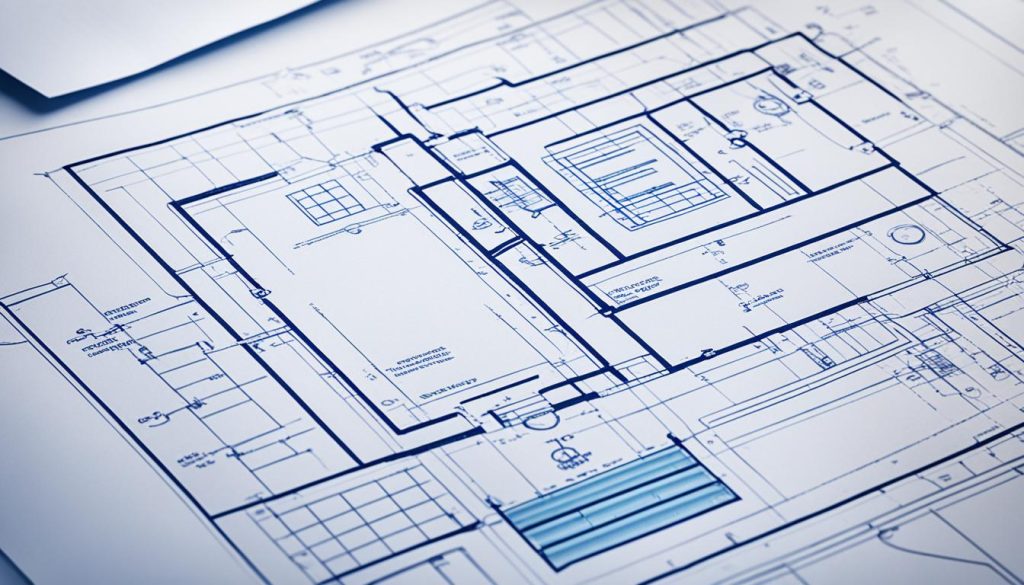
Most big bathroom remodels need permits. They make sure your project meets local rules and safety levels. Small updates like painting or changing fixtures might not require a permit. But, if you’re working on plumbing, electrical, or structural parts, you’ll probably need one.
Here’s a quick list of what usually needs a permit:
- Changing plumbing layouts
- Switching electrical systems
- Making structural changes
- Putting in new fixtures
Getting a permit can take 2-6 months. So, add this to your remodeling timeline. Skilled bathroom remodeling contractors can help you with this, saving time and avoiding mistakes.
Remember, skipping permits can lead to fines, legal issues, and problems when selling your home.
For a smooth process, talk to your local building department early. They can explain what you need for your project. By knowing and following building codes, you’ll have a safe, legal, and successful bathroom renovation.
Selecting the Right Contractor for Your Project
Finding the right bathroom contractor is key to your remodel. A skilled pro can make your dream bathroom a reality. They’ll keep it within your budget and timeline. Let’s look at how to pick the best contractor for your project.
Checking licenses and certifications
First, check the contractor’s credentials. Make sure they have valid licenses and certifications. Look for memberships in groups like the National Kitchen and Bath Association. These memberships show they’re committed to learning and following industry standards.
Evaluating experience and expertise
Experience is important in remodeling bathrooms. Look for contractors with at least five years of experience. Ask to see their past work. Their portfolio will show you their skills and what your project could look like.
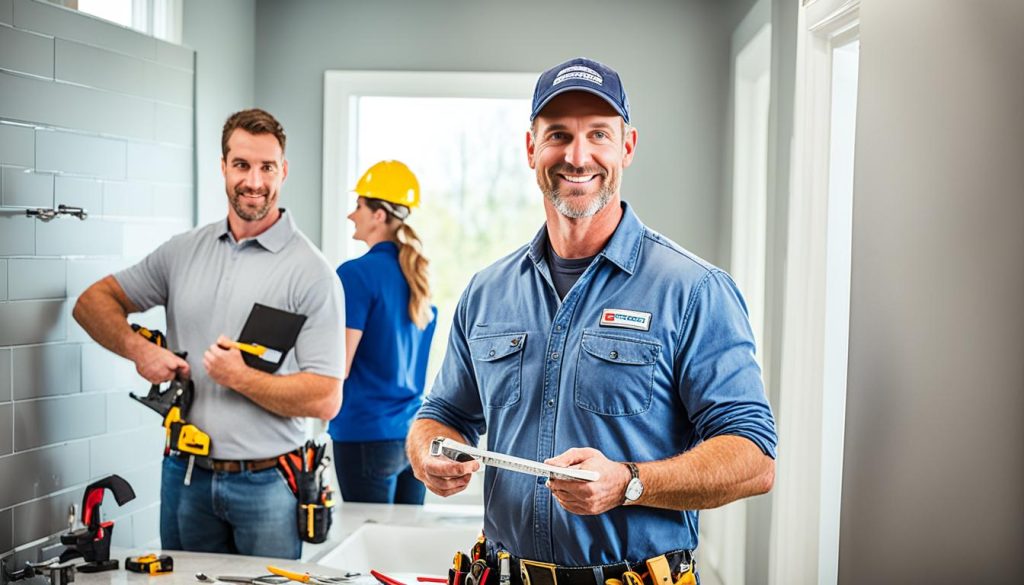
Reading reviews and getting references
Online reviews are crucial when choosing a contractor. Most consumers check these reviews before deciding. But don’t stop there. Ask for references from past clients. Talk to these references about their satisfaction, any budget issues, and if they’d hire the contractor again.
A low bid doesn’t always mean the best deal. Such prices might mean using cheap materials or cutting corners. Look for a contractor who talks well, respects your ideas, and has a good track record of finishing projects on time and within budget.
“A great contractor doesn’t just build bathrooms; they build trust and bring dreams to life.”
By carefully checking out contractors, you’ll increase your chances of a successful bathroom remodel. This will add value to your home and bring you more joy every day.
Designing Your Ideal Bathroom Layout
Creating the perfect bathroom layout is all about planning. It’s important to mix functionality with style, making every inch useful. A well-designed bathroom can make your daily routine feel luxurious.
When looking at bathroom design ideas, think about the size of key fixtures. A standard shower should be about 2 ft 6 inches square. A soaking tub needs at least 3 ft by 6 ft. Toilets usually take up 2 ft 6 inches square, and single vanities need 2 ft width by 1 ft 8 inches depth.
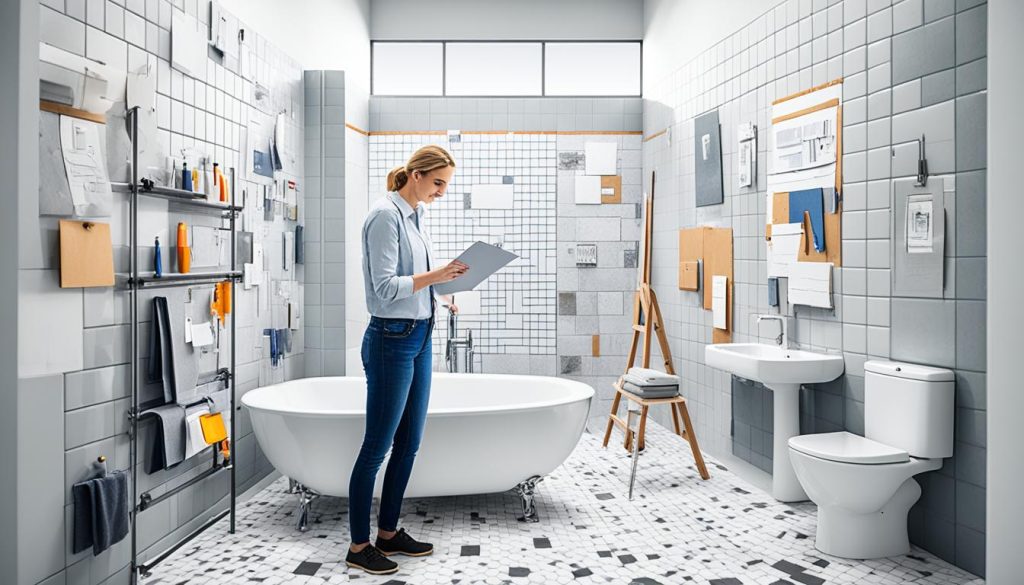
In smaller bathrooms, saving space is key. Choosing a shower over a tub can give you 40% more floor space. For bigger bathrooms, a 10×12-foot area lets you fit in double vanities and freestanding tubs.
Moving plumbing can really up the cost. Even a simple change between fixtures can add $1,500 to your bill. To save money, try to keep plumbing fixtures on one wall if you can.
“A well-planned bathroom layout is the foundation of a functional and beautiful space.”
Your bathroom should match your lifestyle. If showers are your thing, go for a bigger, nicer shower space. If you love soaking, a deep, comfy tub should be the main feature.
Lastly, remember ventilation is key. Good airflow stops structural damage and keeps the air fresh. With careful planning, your new bathroom will be both beautiful and practical.
Choosing Durable and Water-Resistant Flooring Options
Choosing the right flooring for your bathroom is key. You want a material that stands up to moisture and looks good. Let’s look at some top picks that are both tough and stylish.
Ceramic and Porcelain Tile
Bathroom tiles are perfect for wet areas. Ceramic and porcelain are great because they don’t let water through and last a long time. They come in many designs, letting you make cool patterns with your tiles. Plus, they’re easy to keep clean, which is great for busy homes.
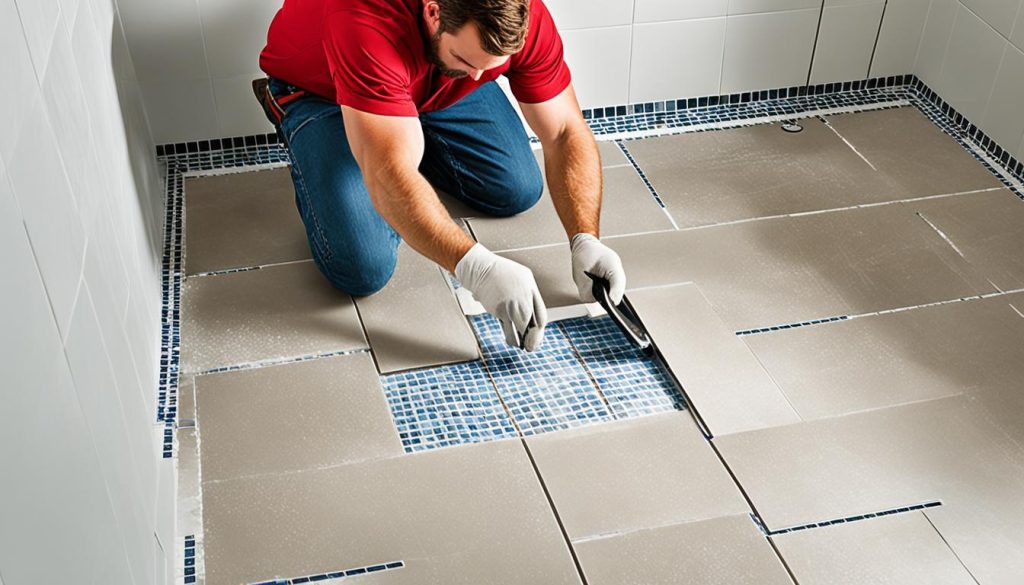
Luxury Vinyl Flooring
Luxury vinyl flooring is a smart choice that’s easy on the wallet but still looks great. It looks like wood or stone but is better at handling water. Vinyl is softer than tile and comes in different styles for easy setup. Many people pick this to make their home more valuable.
Natural Stone Options
Natural stone like marble or slate brings a fancy feel to your bathroom. These stones are pricier but have unique looks. Some stones need sealing to stay water-resistant. With the right care, your stone floor will look amazing for years.
The best flooring depends on your budget, style, and how much you’re willing to clean. Think about how slippery it is and how comfy it feels under your feet. With the right choice, you’ll get a floor that’s both strong and looks good, making your bathroom both useful and nice to look at.
Selecting the Perfect Shower or Bathtub
Choosing the right shower or bathtub is key in your bathroom remodel. The fixtures you pick can greatly affect your space’s look and function. Think about size, style, and budget when picking out fixtures and materials.
Bathtubs come in many materials, each with its own perks. Acrylic tubs are easy on the wallet and light, while cast iron is strong and classic. Copper adds luxury with its natural fight against germs. Fibreglass is the cheapest but not as tough as others.

Here are the standard sizes for bathtubs:
– Alcove: 60″ long, 32″ wide, 18″ deep
– Whirlpool: 60″ long, 32″ wide, 18-23 1⁄4″ deep
– Oval: 60″ long, 41″ wide, 24″ deep
– Corner: 60″ long, 60″ wide, 22″ deep
Showers let you get creative with your design. You can go for pre-made units or tile your own. Think about adding features like multiple showerheads, body sprays, or built-in seats for extra comfort. Grab bars are a great idea for safety and ease of use.
“Stick to a maximum of three tile choices for your bathroom design. Subway tile remains a popular and versatile option.”
It’s smart to mix expensive and affordable materials to keep costs down. Getting a pro to install is a good move to avoid leaks. Always talk to a contractor to make sure your fixtures and materials will work well together.
Optimizing Storage with Vanities and Cabinets
Bathroom vanities and storage solutions are key to keeping your space tidy. When remodeling your bathroom, think about adding smart storage to boost functionality and style.
Begin by picking a vanity that fits your space. For big bathrooms, a double-sink vanity with lots of drawers is great. It helps keep things like toiletries and makeup organized. For smaller spaces, a single-sink vanity with smart storage can be just as effective.
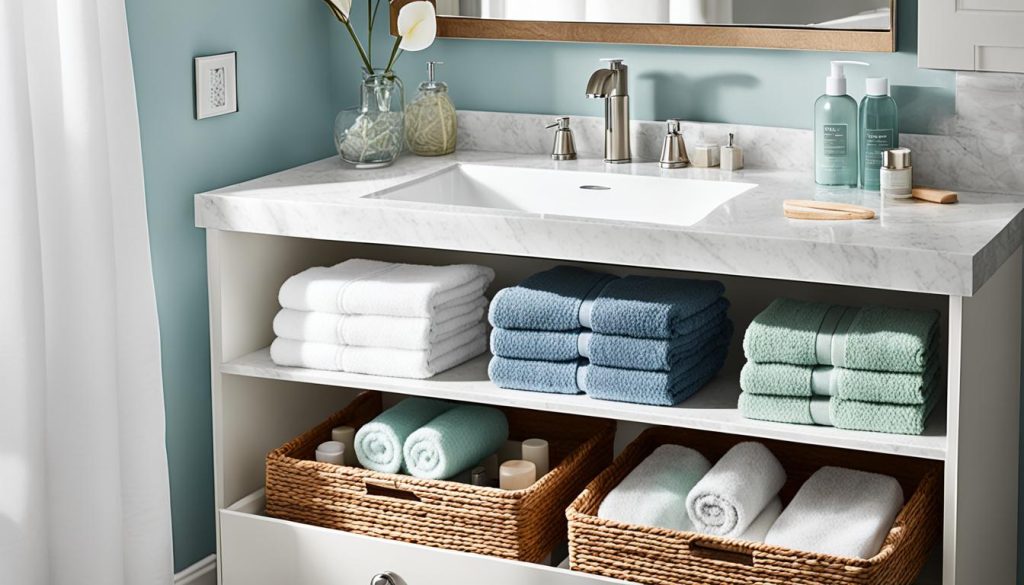
- Pull-out trays for easy access to cleaning supplies
- Drawer dividers to keep small items organized
- Hidden hamper roll-outs for dirty laundry
- Vertical storage for hair styling tools
Wall-mounted storage is also a great idea. Medicine cabinets are ideal for keeping personal care items handy while saving counter space. For a spa-like touch, consider adding open shelving or a linen cabinet for towels and toiletries.
When picking materials for your vanities, choose ones that can stand up to moisture. Look for water-resistant options like treated hardwood or colorful painted laminate cabinets. White cabinets can give your bathroom a clean, elegant look that fits many styles.
“A well-designed vanity with drawers can hold more items compared to cabinets, making it an excellent choice for maximizing storage in your bathroom.”
By planning your storage solutions well, you can make your bathroom both functional and beautiful. It will meet all your needs.
Lighting and Ventilation Considerations
Proper lighting and ventilation are key for a great bathroom. Good lighting changes the feel of your bathroom. It also stops moisture and mold from building up.
Selecting appropriate lighting fixtures
Layering your bathroom lighting is important. Use task, ambient, and accent lighting for both function and style. Here are some ideas:
- Overhead LED lights for general illumination
- Vanity lights for grooming tasks
- Pendant lighting for added style and functionality
Chrome and stainless steel fixtures are popular for their durability and easy care. For saving energy, LED lighting is a great choice for your bathroom remodel.
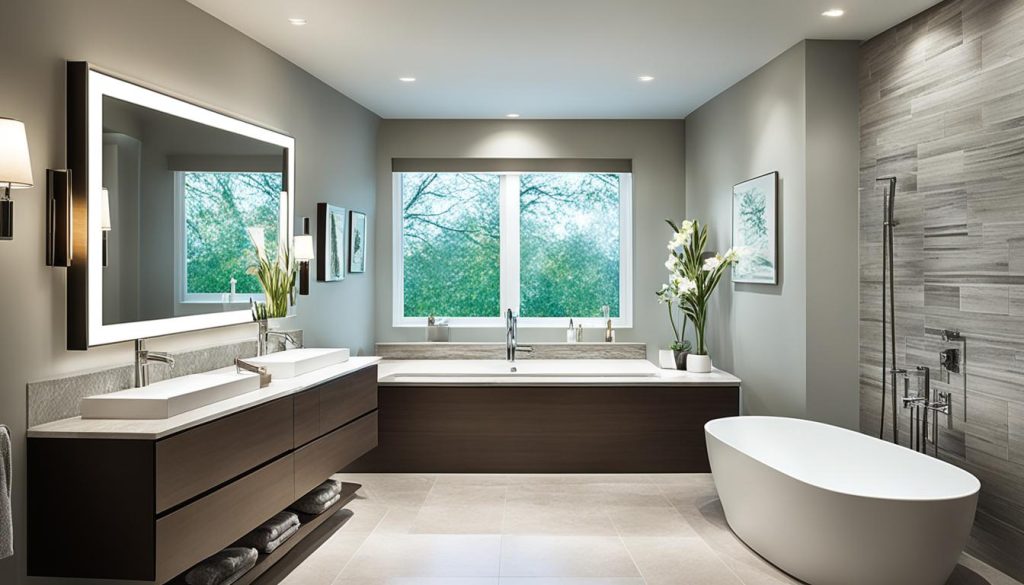
Installing a proper ventilation system
A good exhaust fan is key to stop moisture problems in your bathroom. Choose fans with humidity sensors to save energy. Make sure the fan is the right size for your space. A professional can help pick the best size.
Maximizing natural light
Natural light makes your bathroom feel bigger and more welcoming. Here are ways to get more natural light:
- Install larger windows or skylights
- Use light-colored paint or tiles to reflect light
- Opt for glass shower doors instead of curtains
By focusing on these lighting and ventilation tips, you’ll make a bathroom that’s both beautiful and practical. Talk about your lighting and ventilation plans with your contractor. This ensures they’re installed right and saves you from costly mistakes.
Eco-Friendly Bathroom Remodeling Tips
Green bathroom remodeling ideas are becoming more popular with homeowners. By using eco-friendly elements, you can make a stylish space that’s good for the planet and your wallet.
Water conservation is key in eco-friendly bathroom designs. Think about getting a dual-flush toilet, which uses less than 1.6 gallons per flush. This can save thousands of gallons a year. Also, switch to low-flow showerheads to cut water use by up to 2,700 gallons yearly.
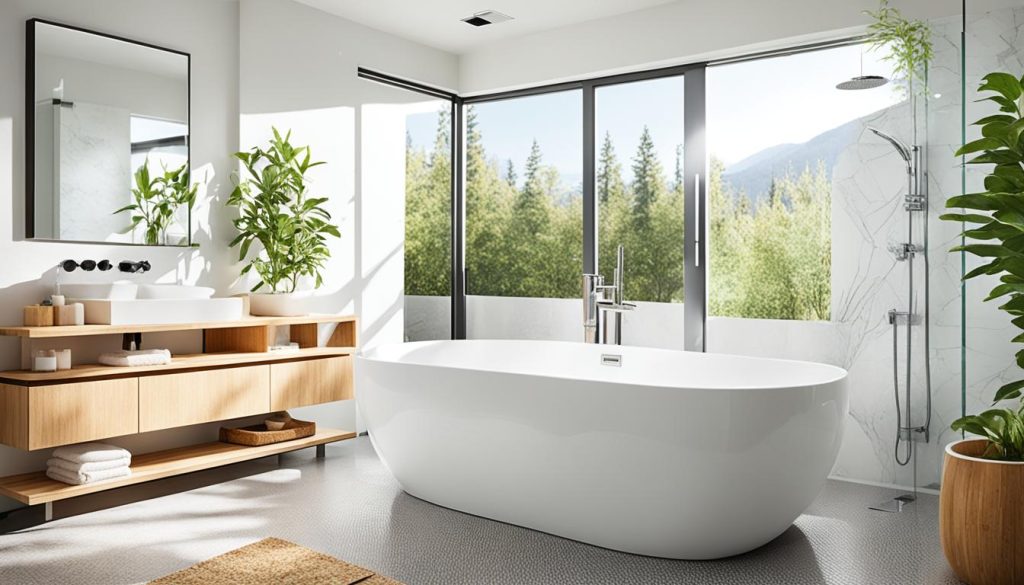
Energy efficiency is vital in green bathroom remodels. Swap old light fixtures for LED or CFL bulbs, which use much less energy than traditional bulbs. Add a smart thermostat to heat your bathroom only when it’s needed, cutting down on energy use even more.
For your bathroom remodel, pick sustainable materials. Recycled glass tiles, reclaimed wood, and natural stone are great for eco-conscious homeowners. For flooring, consider linoleum or cork. These are made from renewable resources and don’t offgas much.
“Green remodeling is not just a trend; it’s a responsible choice for the future of our planet and our homes.”
When planning your eco-friendly bathroom remodel, look for green products early. This makes it easier to find businesses with sustainable items. Be aware of harmful fumes from materials like paint and adhesives during the renovation.
By using these eco-friendly bathroom remodeling tips, you’ll get a space that looks great and is good for the planet. You might even get help financing your green renovations through programs like Mortgage Options for Resource Efficiency (MORE™).
Addressing Plumbing and Electrical Upgrades
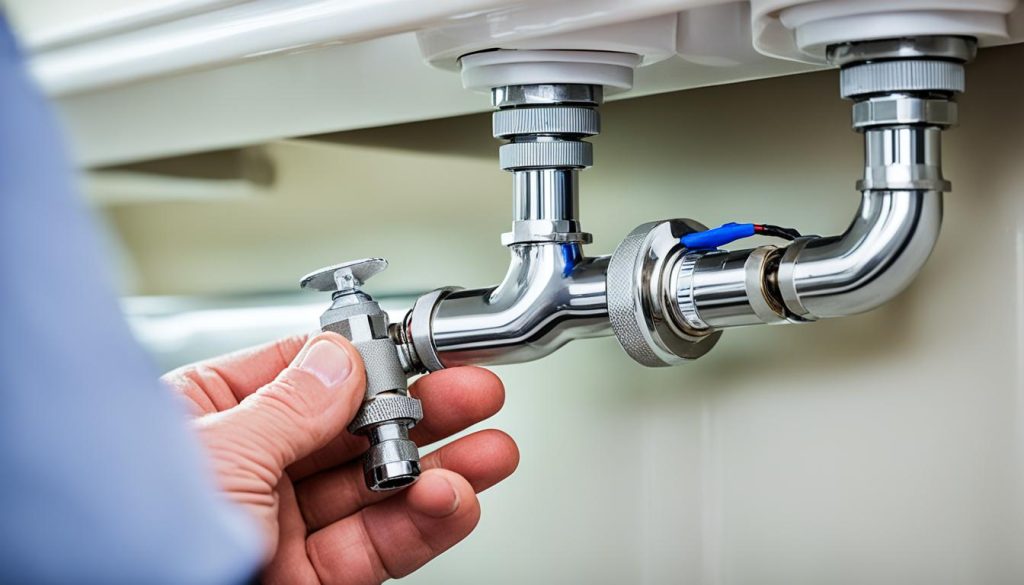
A bathroom renovation is a great time to improve your plumbing and electrical systems. These updates make your home more useful and increase its value. Set aside 4 to 8 weeks for plumbing and electrical work.
It’s key to update old plumbing during a bathroom redo. Use new materials to stop leaks and get better water pressure. This is crucial if you’re changing the layout or adding new features.
Electrical upgrades are also a must. Update your wiring for new lights, heated floors, or smart tech. Always put in GFCI outlets in damp spots for safety.
“Consulting a professional is recommended for plumbing, electrical work, and structural changes.”
While you might try some DIY tasks, it’s smart to hire pros for plumbing and electrical work. Experts make sure your changes follow local rules and keep your home’s value up.
- Plan for possible water damage fixes
- Think about using energy-saving fixtures
- Remember to add good ventilation to avoid moisture problems
By focusing on these important updates, your bathroom will be both lovely and safe. It will also be functional for many years.
Finalizing Your Bathroom’s Style and Aesthetic
Finishing your bathroom design is thrilling. It’s where you make your dream space come true. You get to show off your style. Let’s look at how to pick colors, choose fixtures, and add design elements for a standout bathroom.
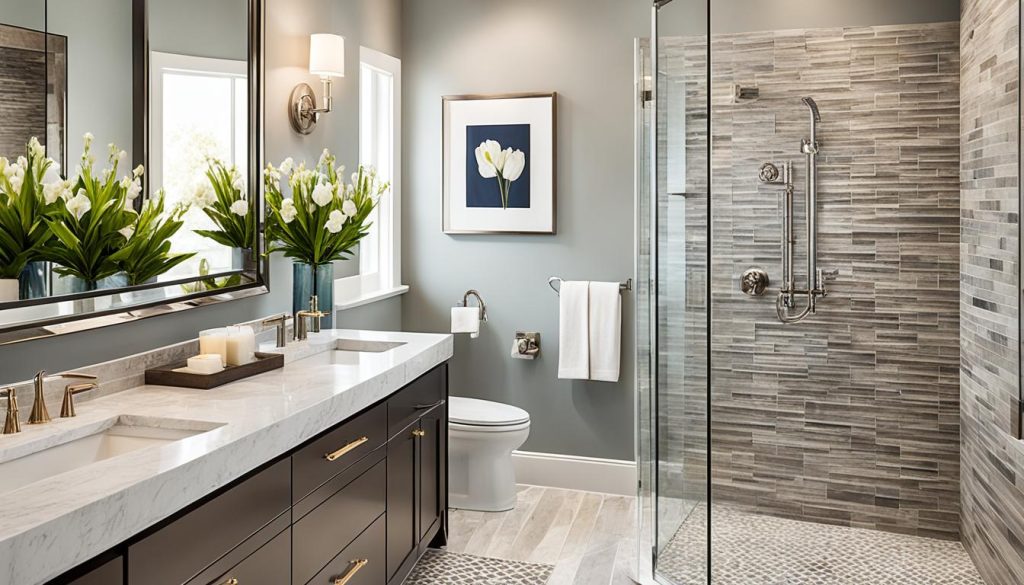
Choosing a Color Scheme
Choosing the right colors sets the mood of your bathroom. Go for a palette that matches the vibe you want. Light colors can make small bathrooms look bigger. Darker colors add drama and elegance. Use satin or semi-gloss paint to keep walls safe from moisture.
Selecting Fixtures and Hardware
The fixtures and hardware you pick greatly affect your bathroom’s look. Make sure they match your style and color scheme. Brushed nickel or chrome is great for modern looks, while oil-rubbed bronze is perfect for traditional styles. Make sure all your faucets, showerheads, and cabinet handles match for a unified look.
Incorporating Design Elements
Add your personal touch with unique design elements. Here are some ideas:
- Install a statement mirror to create a focal point
- Use decorative tiles to create an accent wall
- Hang artwork that complements your color scheme
- Add plants for a touch of nature and freshness
Your bathroom design should show your style and be practical. With careful planning and the right choices, you can make a space you’ll love for years.
Final Thoughts
Starting a bathroom remodel can feel both thrilling and overwhelming. Our guide has shown that careful planning is crucial for success. From the initial planning phase to the construction period, each step is important. A well-planned remodel can turn your bathroom into a beautiful and functional space.
When planning your remodel, consider making a vision board. This can help you see your goals clearly. Think about what you want to change, like making the space brighter or adding more storage. Make sure to measure and plan your design carefully to ensure everything fits well together.
While doing it yourself can save money, know when to get professional help. The author found it helpful to hire a contractor for plumbing and shower installation, and a designer for the floor plans. Having a detailed schedule and budget is also key. With the right planning and execution, you’ll soon enjoy your new bathroom that reflects your style and meets your family’s needs.


